2006 CHEVROLET CORVETTE oil dipstick
[x] Cancel search: oil dipstickPage 256 of 426

Of course, traction is reduced when water, snow, ice,
gravel, or other material is on the road. For safety, you
will want to slow down and adjust your driving to
these conditions. It is important to slow down on slippery
surfaces because stopping distance will be longer and
vehicle control more limited.
While driving on a surface with reduced traction, try
your best to avoid sudden steering, acceleration, or
braking, including reducing vehicle speed by shifting to
a lower gear. Any sudden changes could cause the tires
to slide. You may not realize the surface is slippery until
your vehicle is skidding. Learn to recognize warning
clues — such as enough water, ice, or packed snow on
the road to make a mirrored surface — and slow down
when you have any doubt.
Remember: Any Anti-Lock Brake System (ABS) helps
avoid only the braking skid.
Racing or Other Competitive Driving
See your warranty book before using your vehicle for
racing or other competitive driving.
Notice:If you use your vehicle for racing or other
competitive driving, the engine may use more oil than
it would with normal use. Low oil levels can damage
the engine. For information on how to add oil, see
Engine Oil on page 5-16.Z06 Only: Be sure to check the oil level often during
racing or other competitive driving and keep the
level at or near the upper mark that shows the
proper operating range on the engine oil dipstick.
Except Z06: Be sure to check the oil level often
during racing or other competitive driving and keep
the level at or near 1 quart (1 L) above the upper
mark that shows the proper operating range on the
engine oil dipstick. After the competitive driving,
remove excess oil so that the level on the dipstick is
not above the upper mark that shows the proper
operating range.
Vehicles with the Z51 performance package have
greaseable outer ends on both of the rear toe-links.
Under normal use, lubrication should be performed as
described in the maintenance schedule. SeeScheduled
Maintenance on page 6-4andRecommended Fluids
and Lubricants on page 6-12. If you use the vehicle for
racing, lubrication should be performed at the end of
each racing day. See your dealer for lubrication
and make sure any needed repairs are made at once.
Proper procedures for performing these services can be
found in the service manual. SeeService Publications
Ordering Information on page 7-14.
4-18
Page 289 of 426
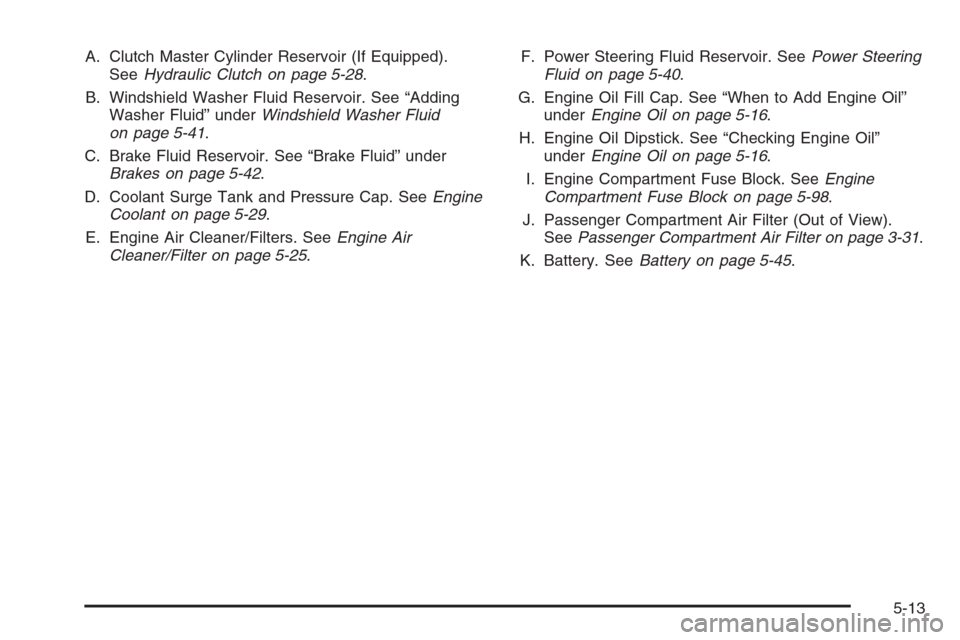
A. Clutch Master Cylinder Reservoir (If Equipped).
SeeHydraulic Clutch on page 5-28.
B. Windshield Washer Fluid Reservoir. See “Adding
Washer Fluid” underWindshield Washer Fluid
on page 5-41.
C. Brake Fluid Reservoir. See “Brake Fluid” under
Brakes on page 5-42.
D. Coolant Surge Tank and Pressure Cap. SeeEngine
Coolant on page 5-29.
E. Engine Air Cleaner/Filters. SeeEngine Air
Cleaner/Filter on page 5-25.F. Power Steering Fluid Reservoir. SeePower Steering
Fluid on page 5-40.
G. Engine Oil Fill Cap. See “When to Add Engine Oil”
underEngine Oil on page 5-16.
H. Engine Oil Dipstick. See “Checking Engine Oil”
underEngine Oil on page 5-16.
I. Engine Compartment Fuse Block. SeeEngine
Compartment Fuse Block on page 5-98.
J. Passenger Compartment Air Filter (Out of View).
SeePassenger Compartment Air Filter on page 3-31.
K. Battery. SeeBattery on page 5-45.
5-13
Page 291 of 426
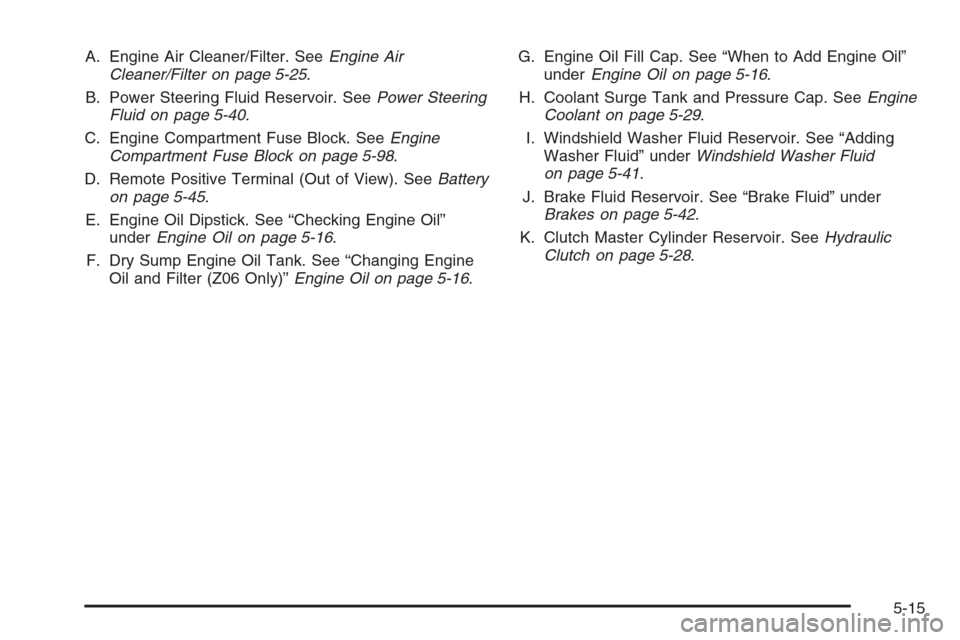
A. Engine Air Cleaner/Filter. SeeEngine Air
Cleaner/Filter on page 5-25.
B. Power Steering Fluid Reservoir. SeePower Steering
Fluid on page 5-40.
C. Engine Compartment Fuse Block. SeeEngine
Compartment Fuse Block on page 5-98.
D. Remote Positive Terminal (Out of View). SeeBattery
on page 5-45.
E. Engine Oil Dipstick. See “Checking Engine Oil”
underEngine Oil on page 5-16.
F. Dry Sump Engine Oil Tank. See “Changing Engine
Oil and Filter (Z06 Only)”Engine Oil on page 5-16.G. Engine Oil Fill Cap. See “When to Add Engine Oil”
underEngine Oil on page 5-16.
H. Coolant Surge Tank and Pressure Cap. SeeEngine
Coolant on page 5-29.
I. Windshield Washer Fluid Reservoir. See “Adding
Washer Fluid” underWindshield Washer Fluid
on page 5-41.
J. Brake Fluid Reservoir. See “Brake Fluid” under
Brakes on page 5-42.
K. Clutch Master Cylinder Reservoir. SeeHydraulic
Clutch on page 5-28.
5-15
Page 292 of 426
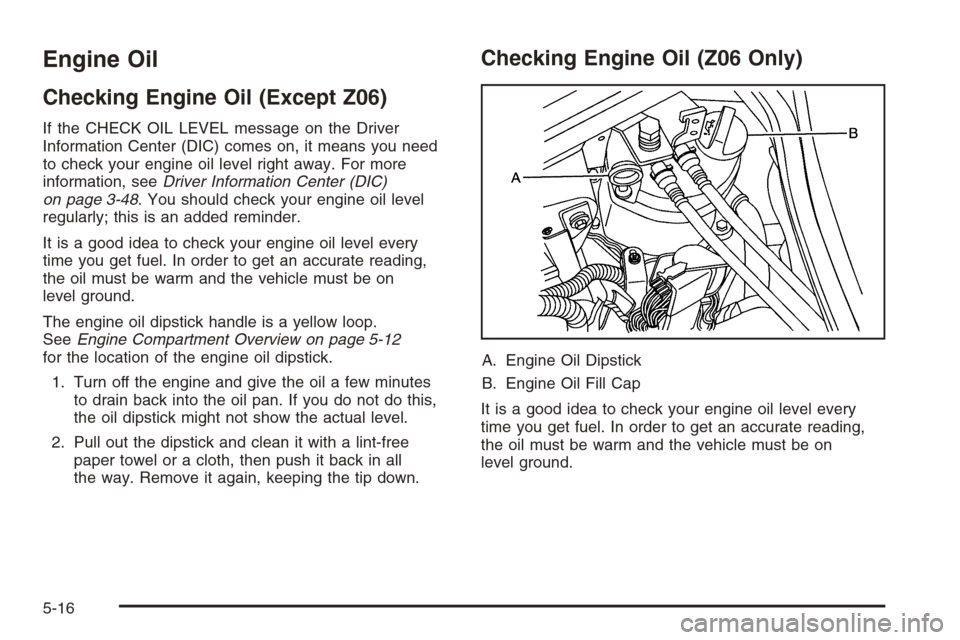
Engine Oil
Checking Engine Oil (Except Z06)
If the CHECK OIL LEVEL message on the Driver
Information Center (DIC) comes on, it means you need
to check your engine oil level right away. For more
information, seeDriver Information Center (DIC)
on page 3-48. You should check your engine oil level
regularly; this is an added reminder.
It is a good idea to check your engine oil level every
time you get fuel. In order to get an accurate reading,
the oil must be warm and the vehicle must be on
level ground.
The engine oil dipstick handle is a yellow loop.
SeeEngine Compartment Overview on page 5-12
for the location of the engine oil dipstick.
1. Turn off the engine and give the oil a few minutes
to drain back into the oil pan. If you do not do this,
the oil dipstick might not show the actual level.
2. Pull out the dipstick and clean it with a lint-free
paper towel or a cloth, then push it back in all
the way. Remove it again, keeping the tip down.
Checking Engine Oil (Z06 Only)
A. Engine Oil Dipstick
B. Engine Oil Fill Cap
It is a good idea to check your engine oil level every
time you get fuel. In order to get an accurate reading,
the oil must be warm and the vehicle must be on
level ground.
5-16
Page 293 of 426
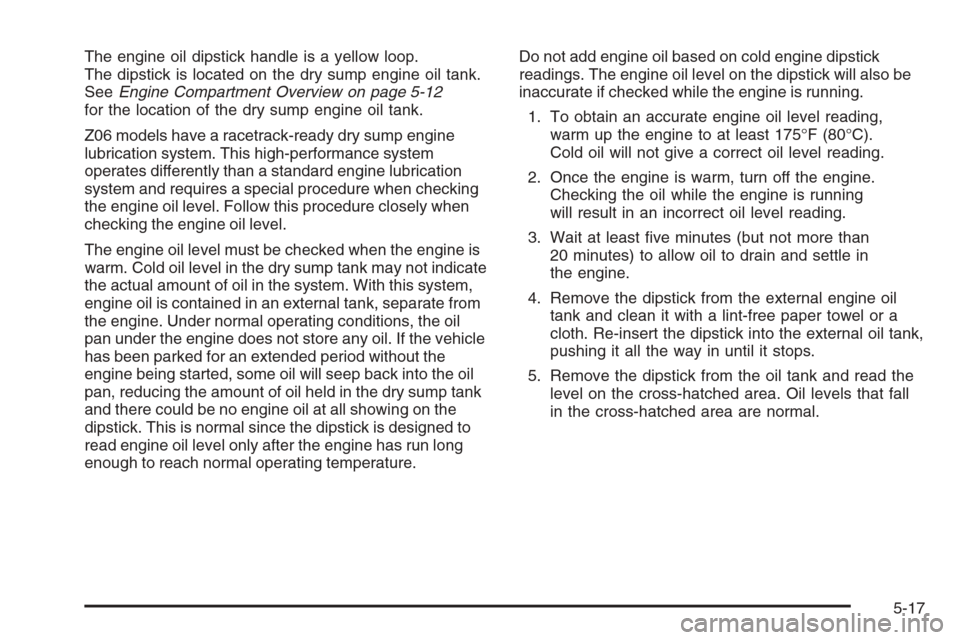
The engine oil dipstick handle is a yellow loop.
The dipstick is located on the dry sump engine oil tank.
SeeEngine Compartment Overview on page 5-12
for the location of the dry sump engine oil tank.
Z06 models have a racetrack-ready dry sump engine
lubrication system. This high-performance system
operates differently than a standard engine lubrication
system and requires a special procedure when checking
the engine oil level. Follow this procedure closely when
checking the engine oil level.
The engine oil level must be checked when the engine is
warm. Cold oil level in the dry sump tank may not indicate
the actual amount of oil in the system. With this system,
engine oil is contained in an external tank, separate from
the engine. Under normal operating conditions, the oil
pan under the engine does not store any oil. If the vehicle
has been parked for an extended period without the
engine being started, some oil will seep back into the oil
pan, reducing the amount of oil held in the dry sump tank
and there could be no engine oil at all showing on the
dipstick. This is normal since the dipstick is designed to
read engine oil level only after the engine has run long
enough to reach normal operating temperature.Do not add engine oil based on cold engine dipstick
readings. The engine oil level on the dipstick will also be
inaccurate if checked while the engine is running.
1. To obtain an accurate engine oil level reading,
warm up the engine to at least 175°F (80°C).
Cold oil will not give a correct oil level reading.
2. Once the engine is warm, turn off the engine.
Checking the oil while the engine is running
will result in an incorrect oil level reading.
3. Wait at least �ve minutes (but not more than
20 minutes) to allow oil to drain and settle in
the engine.
4. Remove the dipstick from the external engine oil
tank and clean it with a lint-free paper towel or a
cloth. Re-insert the dipstick into the external oil tank,
pushing it all the way in until it stops.
5. Remove the dipstick from the oil tank and read the
level on the cross-hatched area. Oil levels that fall
in the cross-hatched area are normal.
5-17
Page 294 of 426
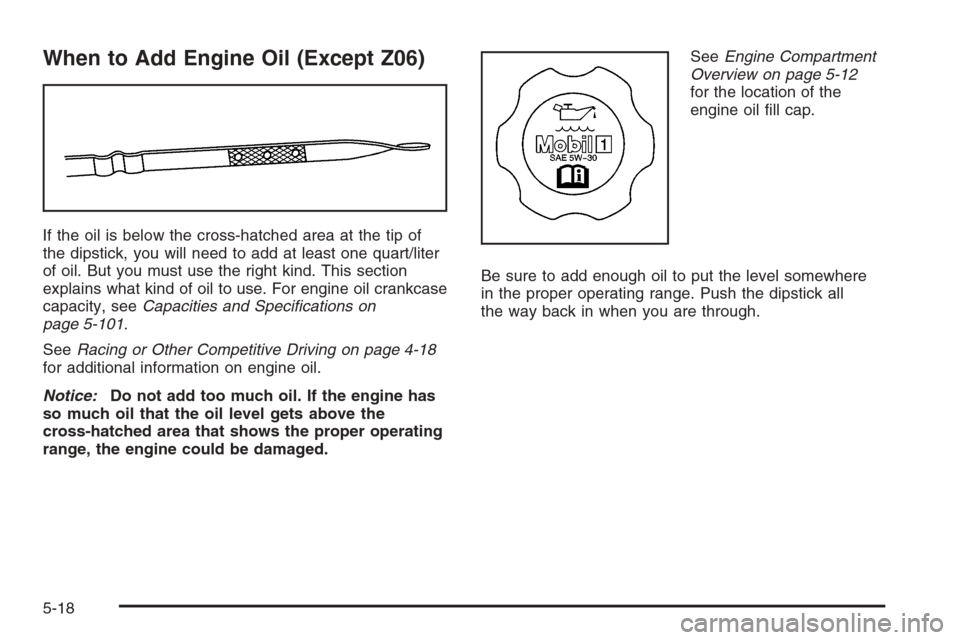
When to Add Engine Oil (Except Z06)
If the oil is below the cross-hatched area at the tip of
the dipstick, you will need to add at least one quart/liter
of oil. But you must use the right kind. This section
explains what kind of oil to use. For engine oil crankcase
capacity, seeCapacities and Speci�cations on
page 5-101.
SeeRacing or Other Competitive Driving on page 4-18
for additional information on engine oil.
Notice:Do not add too much oil. If the engine has
so much oil that the oil level gets above the
cross-hatched area that shows the proper operating
range, the engine could be damaged.SeeEngine Compartment
Overview on page 5-12
for the location of the
engine oil �ll cap.
Be sure to add enough oil to put the level somewhere
in the proper operating range. Push the dipstick all
the way back in when you are through.
5-18
Page 295 of 426
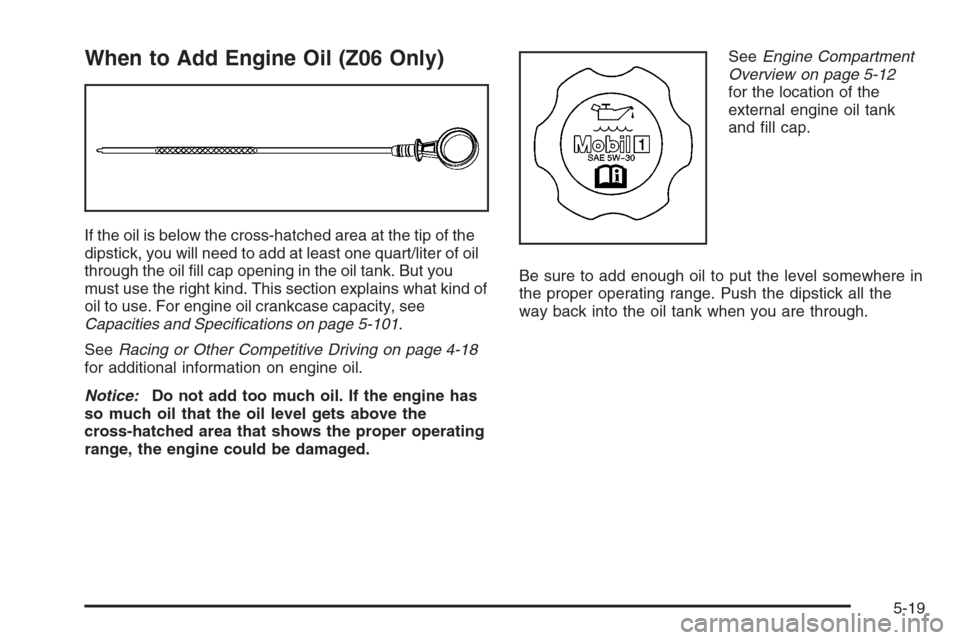
When to Add Engine Oil (Z06 Only)
If the oil is below the cross-hatched area at the tip of the
dipstick, you will need to add at least one quart/liter of oil
through the oil �ll cap opening in the oil tank. But you
must use the right kind. This section explains what kind of
oil to use. For engine oil crankcase capacity, see
Capacities and Speci�cations on page 5-101.
SeeRacing or Other Competitive Driving on page 4-18
for additional information on engine oil.
Notice:Do not add too much oil. If the engine has
so much oil that the oil level gets above the
cross-hatched area that shows the proper operating
range, the engine could be damaged.SeeEngine Compartment
Overview on page 5-12
for the location of the
external engine oil tank
and �ll cap.
Be sure to add enough oil to put the level somewhere in
the proper operating range. Push the dipstick all the
way back into the oil tank when you are through.
5-19
Page 297 of 426
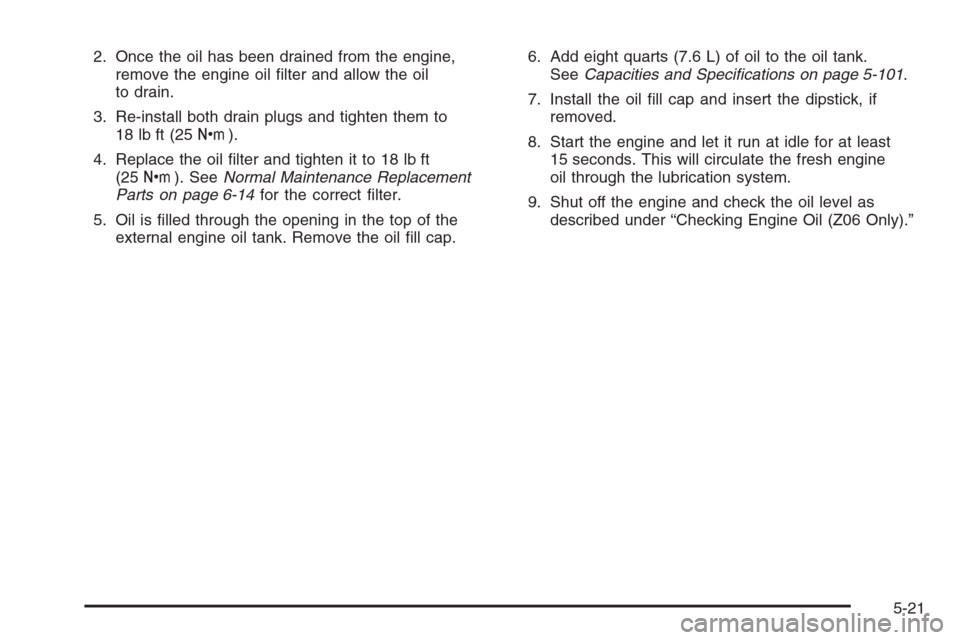
2. Once the oil has been drained from the engine,
remove the engine oil �lter and allow the oil
to drain.
3. Re-install both drain plugs and tighten them to
18 lb ft (25Y).
4. Replace the oil �lter and tighten it to 18 lb ft
(25Y). SeeNormal Maintenance Replacement
Parts on page 6-14for the correct �lter.
5. Oil is �lled through the opening in the top of the
external engine oil tank. Remove the oil �ll cap.6. Add eight quarts (7.6 L) of oil to the oil tank.
SeeCapacities and Speci�cations on page 5-101.
7. Install the oil �ll cap and insert the dipstick, if
removed.
8. Start the engine and let it run at idle for at least
15 seconds. This will circulate the fresh engine
oil through the lubrication system.
9. Shut off the engine and check the oil level as
described under “Checking Engine Oil (Z06 Only).”
5-21